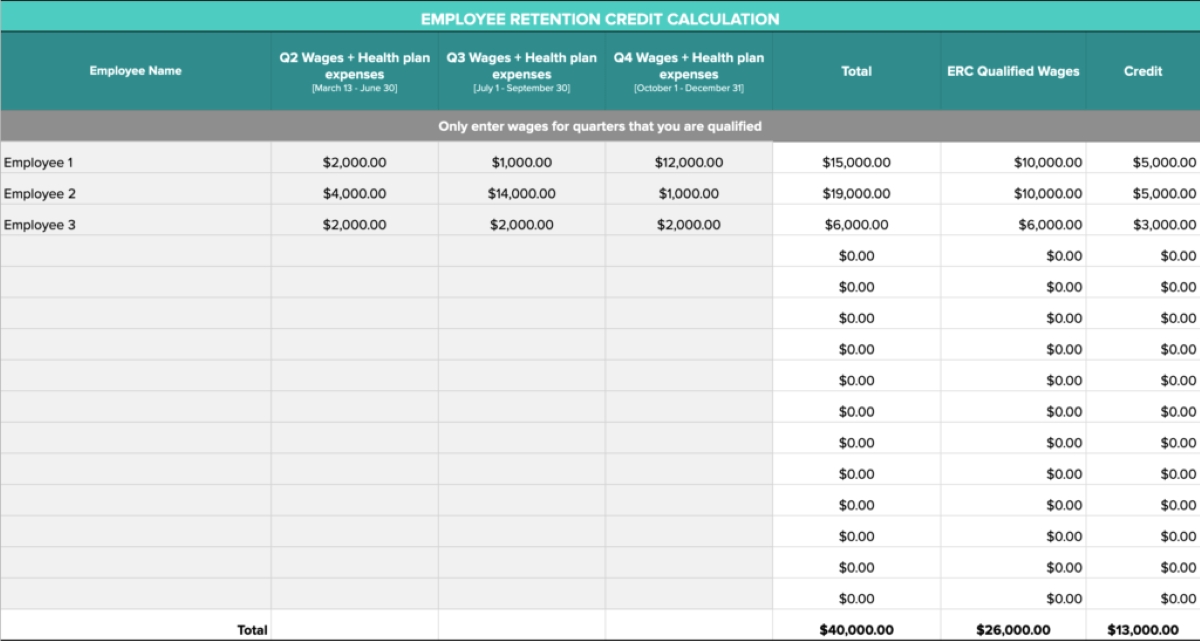Home>Finance>What Is The Nonrefundable Portion Of Employee Retention Credit


Finance
What Is The Nonrefundable Portion Of Employee Retention Credit
Modified: February 21, 2024
Learn about the nonrefundable portion of the Employee Retention Credit in finance, its benefits, and how it can help your business save money.
(Many of the links in this article redirect to a specific reviewed product. Your purchase of these products through affiliate links helps to generate commission for LiveWell, at no extra cost. Learn more)
Table of Contents
Introduction
As we navigate through unprecedented times brought about by the COVID-19 pandemic, businesses around the world are searching for ways to support their employees and stay afloat. In response to this, the U.S. government introduced the Employee Retention Credit (ERC) as part of the CARES Act.
The ERC is a valuable tax credit designed to provide financial assistance to employers who have been significantly impacted by the pandemic. It aims to encourage businesses to retain their employees, even in the face of economic uncertainty.
While the ERC offers substantial benefits, it’s essential to understand the different components of this credit. One such element is the nonrefundable portion, which has specific eligibility criteria, calculations, and limitations. In this article, we will delve into the details of the nonrefundable portion of the Employee Retention Credit.
By gaining a comprehensive understanding of this aspect, business owners can maximize their eligibility and effectively utilize the ERC to support their employees and their bottom line.
Understanding the Employee Retention Credit
The Employee Retention Credit (ERC) is a tax credit designed to provide financial relief to businesses that have experienced significant disruptions due to the COVID-19 pandemic. It was introduced under the Coronavirus Aid, Relief, and Economic Security (CARES) Act in March 2020 and has been extended and expanded by subsequent legislation.
The ERC allows eligible employers to claim a tax credit for a percentage of qualified wages paid to their employees during a specific period. The credit is intended to incentivize businesses to retain their employees even during times of economic uncertainty.
To qualify for the ERC, a business must meet certain criteria:
- The business must have experienced a full or partial suspension of operations due to a government order related to COVID-19, OR
- The business must have experienced a significant decline in gross receipts compared to the same period in the previous year.
The eligible period for claiming the credit depends on the specific legislation in effect. Initially, the ERC applied to wages paid between March 13, 2020, and December 31, 2020. However, with subsequent legislation, the credit has been extended through December 31, 2021.
The amount of the ERC that a business can claim is based on a percentage of qualified wages paid to eligible employees. Initially, the credit was set at 50% of qualified wages, up to $10,000 per employee per year. However, with subsequent legislation, the credit percentage has increased to 70% of qualified wages, up to $10,000 per employee per quarter.
It’s important to note that businesses cannot claim the ERC on wages that have been used to calculate other credits, such as the Paid Sick Leave Credit or the Paid Family Leave Credit under the Families First Coronavirus Response Act.
The ERC is a valuable source of support for businesses that have been impacted by the pandemic. It can help offset the financial burden of retaining employees and reduce overall operating costs during these challenging times.
Exploring the Nonrefundable Portion
Within the Employee Retention Credit (ERC), there is a component known as the nonrefundable portion. The nonrefundable portion refers to the part of the credit that cannot exceed the employer’s total liability for Social Security taxes in a given calendar quarter.
Simply put, if the calculated credit amount is greater than the employer’s Social Security tax liability for the quarter, the excess amount is considered nonrefundable. This means that the employer can only utilize the credit up to the extent of their Social Security tax liability, and any remaining balance cannot be claimed or refunded.
The purpose of the nonrefundable portion is to ensure that the ERC does not create a situation where businesses could potentially receive a refund from the government that exceeds their actual tax liability.
It’s important to note that even though the nonrefundable portion cannot be claimed as a refund, it can still be carried forward to future quarters. This allows businesses to offset their Social Security tax liability using the nonrefundable portion of the credit in subsequent periods.
For example, let’s say a business has a calculated ERC of $15,000 for a specific quarter, but their Social Security tax liability for the same quarter is only $10,000. In this scenario, the nonrefundable portion of the credit would be $10,000, and the remaining $5,000 cannot be claimed or refunded. However, the business can carry forward the unused $5,000 to offset their future Social Security tax liability.
It’s essential for businesses to carefully calculate and track their nonrefundable portion of the ERC to ensure accurate reporting and compliance. Properly accounting for the nonrefundable portion will help businesses avoid any potential errors or penalties during tax filings.
Overall, while the nonrefundable portion of the ERC may limit the refundability of the credit in certain instances, it still offers significant value to businesses by reducing their Social Security tax liability and providing support during challenging economic times.
Eligibility Criteria for the Nonrefundable Portion
To determine the eligibility for the nonrefundable portion of the Employee Retention Credit (ERC), businesses must meet specific criteria in addition to meeting the general eligibility requirements for the credit.
Here are the key eligibility criteria for the nonrefundable portion:
- Employer status: The business must be an eligible employer as defined by the ERC guidelines. Generally, this includes businesses of all sizes, except for state and local governments and their instrumentalities.
- Operations partially or fully suspended: The business must have experienced either a full or partial suspension of operations due to a government order related to COVID-19. This could include orders to close certain non-essential businesses or restrictions on certain activities.
- Significant decline in gross receipts: Alternatively, the business can be eligible if it has experienced a significant decline in gross receipts. Initially, the threshold was a 50% decline compared to the same calendar quarter in the previous year. However, with subsequent legislation, the threshold has been lowered to a 20% decline.
- Qualified wages: The business must have paid qualified wages to its employees during the eligible period. Qualified wages include both cash compensation and certain qualified health plan expenses. However, there are limitations and exclusions on the types of wages that can be considered for the ERC.
- Employment retention: To be eligible for the nonrefundable portion, the employer must have maintained an average of 500 or fewer full-time employees during 2019. If the employer had more than 500 employees in 2019, they would be considered a large employer, and different rules and calculations would apply.
It’s crucial for businesses to carefully document and track their eligibility for the nonrefundable portion of the ERC. This includes maintaining records of government orders or agreements, financial statements depicting the decline in gross receipts, and payroll records showcasing qualified wage payments during the eligible period.
By meeting the eligibility criteria for the nonrefundable portion, businesses can effectively utilize the ERC to reduce their Social Security tax liability and provide much-needed financial relief during these challenging times.
Calculation and Limitations of the Nonrefundable Portion
The calculation of the nonrefundable portion of the Employee Retention Credit (ERC) involves determining the employer’s total liability for Social Security taxes and comparing it to the calculated credit amount. There are also certain limitations to consider when determining the nonrefundable portion.
The nonrefundable portion is capped at the employer’s total liability for Social Security taxes in a given calendar quarter. Social Security taxes are calculated based on the wages paid to employees, subject to the Social Security tax rate. The current rate for Social Security tax is 6.2% on wages up to a certain limit.
Here’s a breakdown of the calculation and limitations of the nonrefundable portion:
- Calculate the eligible credit amount: To determine the total credit amount, businesses must calculate the qualified wages paid to eligible employees during the eligible periods. Initially, the credit was set at 50% of qualified wages, up to $10,000 per employee per year. However, with subsequent legislation, the credit percentage has increased to 70% of qualified wages, up to $10,000 per employee per quarter.
- Compare the credit amount to the Social Security tax liability: The nonrefundable portion is determined by comparing the calculated credit amount to the employer’s total liability for Social Security taxes in the same calendar quarter. If the credit amount exceeds the Social Security tax liability, the excess amount is considered nonrefundable.
- Carry forward unused credit: Any nonrefundable portion of the credit cannot be claimed or refunded. However, it can be carried forward to future quarters to offset Social Security tax liabilities in subsequent periods.
- Consider interaction with other relief programs: It’s important to note that the nonrefundable portion of the ERC cannot be claimed on wages that have been used to calculate other credits, such as the Paid Sick Leave Credit or the Paid Family Leave Credit under the Families First Coronavirus Response Act. This prevents double-dipping and ensures appropriate application of the credits.
Businesses should carefully track their qualified wages, calculate the eligible credit amount, and compare it to their Social Security tax liability to determine the nonrefundable portion accurately. Proper documentation and record-keeping are essential to ensure accurate reporting and compliance with ERC guidelines.
Understanding the calculation and limitations of the nonrefundable portion allows businesses to leverage the ERC effectively, reduce their Social Security tax liability, and provide much-needed financial support during these challenging times.
Interaction with Other COVID-19 Relief Programs
The Employee Retention Credit (ERC) is a valuable tax credit that provides financial relief to businesses impacted by the COVID-19 pandemic. However, it’s important to understand how the ERC interacts with other COVID-19 relief programs to avoid any duplication or unintended consequences.
The ERC interacts with various relief programs, including:
- Paycheck Protection Program (PPP): The ERC and the PPP are two separate programs designed to support businesses during the pandemic. Initially, businesses were not allowed to claim both the PPP loan and the ERC for the same wages. However, with the enactment of the Consolidated Appropriations Act, businesses can now claim the ERC even if they have received a PPP loan. However, wages used for PPP loan forgiveness cannot be used to calculate the ERC.
- Families First Coronavirus Response Act (FFCRA) Credits: The FFCRA provides paid sick leave and expanded family and medical leave to eligible employees. Employers can claim tax credits for the wages paid under the FFCRA. However, wages that have been used to calculate FFCRA tax credits cannot be used to calculate the ERC. This ensures that there is no double-dipping of benefits.
- Work Opportunity Tax Credit (WOTC): The WOTC is a tax credit designed to incentivize employers to hire individuals from certain target groups. Eligible employers can claim the WOTC for qualified individuals. However, the same wages cannot be used to calculate both the WOTC and the ERC.
- Other tax credits and deferrals: Some businesses may also be eligible for tax credits or deferrals related to qualified sick leave and family leave wages or the employer’s share of Medicare tax. It’s important to understand the interplay between these programs and the ERC to ensure accurate calculation and utilization of the available credits.
Proper coordination and understanding of the interaction between the ERC and other relief programs are crucial to avoid any unintended consequences, such as duplicate benefits or noncompliance. Businesses should consult with tax professionals or advisors to navigate the complexities of these programs and maximize their eligibility for available relief options.
By utilizing the appropriate relief programs in a coordinated and compliant manner, businesses can access the financial support they need to retain their employees and weather the challenges posed by the ongoing pandemic.
Conclusion
The nonrefundable portion of the Employee Retention Credit (ERC) plays a vital role in providing financial support to businesses impacted by the COVID-19 pandemic. Understanding how the nonrefundable portion works and its interaction with other relief programs is crucial for businesses looking to maximize their eligibility and utilize the credit effectively.
By meeting the eligibility criteria, businesses can access the valuable ERC and claim a percentage of qualified wages paid to employees during the eligible periods. However, it’s important to note that the nonrefundable portion of the credit cannot exceed the employer’s total liability for Social Security taxes in a given calendar quarter.
Although the nonrefundable portion limits the refundability of the credit, any unused portion can be carried forward to offset future Social Security tax liabilities. This ensures that businesses can still benefit from the credit in subsequent periods.
Furthermore, businesses should be aware of the interaction between the ERC and other COVID-19 relief programs, such as the Paycheck Protection Program, Families First Coronavirus Response Act credits, and the Work Opportunity Tax Credit. Understanding how these programs interplay will help businesses avoid duplicating benefits and ensure compliance with program guidelines.
In conclusion, the nonrefundable portion of the Employee Retention Credit provides valuable financial relief to businesses during these challenging times. By carefully calculating the credit and following the guidelines, businesses can reduce their Social Security tax liability, retain their employees, and navigate through the economic uncertainties caused by the pandemic.
For businesses seeking to leverage the ERC, consulting with tax professionals or advisors is highly recommended. They can provide guidance on eligibility requirements, calculation methods, and the proper utilization of the credit for optimal financial benefits.
As the COVID-19 situation continues to evolve, it is essential for businesses to stay updated on any changes or extensions to the ERC and other relief programs. By staying informed and taking advantage of available resources, businesses can navigate through these challenging times and emerge stronger on the other side.














